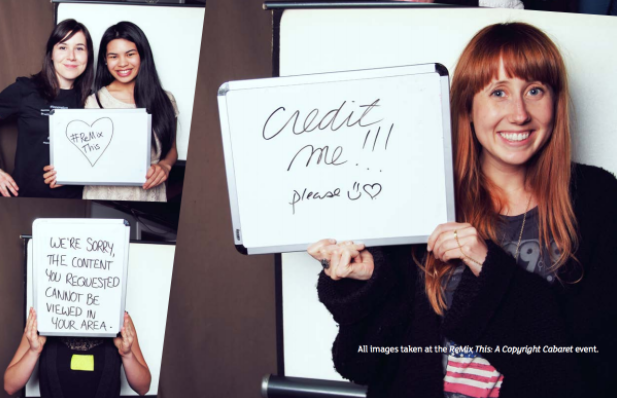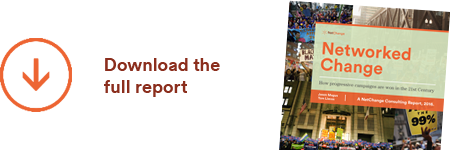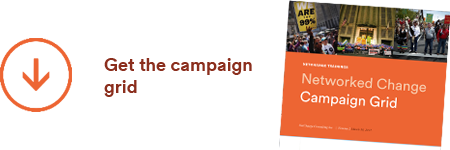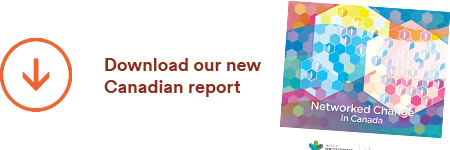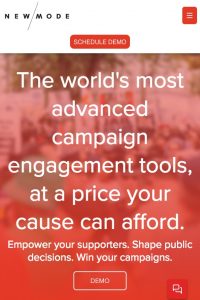
We’ve started this fall to help a new advocacy software start-up better tell its story and connect with more clients. New/Mode’s highly focused software helps campaigners win by unleashing “full spectrum engagement” on advocacy targets, which is why we love them so much. More on the partnership in a future post.
New/Mode’s co-founder, Steve Anderson, also created Canada’s leading digital-first NGO, now a global player. I was always impressed with the team at OpenMedia not only due to the sheer scale of their rapid response petitions and acquisition work (they built the biggest list in the country outside of Avaaz) and their ability to win campaigns, even in highly hostile political environments. OpenMedia’s people power won not only because of scale but in how they used it, a direct result of their sophisticated, thoughtful supporter engagement techniques.
Here’s an excerpt from Steve’s excellent blog post laying down what that team learned over many years on how to do community engagement right.
Now more than ever we have to get democratic engagement right.
I’m certainly not the first person to suggest overly relying on petitions is a problem for progressive campaigners. Indeed full-spectrum engagement fits within broader models of networked or engagement organizing, which is increasingly being adopted by campaigners.
I’m here to add my voice to the growing chorus saying our engagement practices must be relentlessly focused on building community power.
And that means, before putting up another petition, starting from engagement principles for empowering our community, then selecting the best tools to do the job. Sometimes petitions will be the best tool if you’re trying recruit new members to your community, and other times you’ll want to focus more on deeper and often more sophisticated and impactful engagement tools.
To that end, I hope campaigners find the community engagement principles below helpful. These principles came together from experience running digital rights campaigns in several regions, cross-sector campaigning and a review of recent successful campaigns and civic engagement studies.
Community Engagement Principles
*These principles do not necessarily require sophisticated tools — they can be employed in basic social media engagement, all the way to sophisticated crowdsourcing and voter engagement programs.
Overall guiding principle: Treat your community as busy but intelligent people. Speak to the best in people and our common values.
Show Malleability:
- Demonstrate how the political system and society is malleable, and how civic actions in community have an impact.
- Show a compelling theory of change — how campaign tactics will lead to a desired outcome. Research shows that those who do not take action are held back in part because they did not believe that their actions would have an impact.
- Provide a roadmap that shows how the process will work — how community members will get from A to B and make a difference. Illustrate the theory of change as much as possible.
Imagine if you bought Ikea furniture but weren’t given instructions. When we ask people to send a message to regulators, we should also say that if you submit a message we’ll attend a hearing on your behalf and that the combination of people speaking out, alongside expert testimony, will create a powerful force.
Give Recognition:
- Cynicism is our greatest enemy. As the Google civic engagement study notes the largest block of the population in western democracies is held back from engagement in part because they wonder: “Even if I do something, will anything actually change?”. As much as possible put on display the impact participants are making in the world.
- Take the time to recognize those who contribute to your project: Research shows people want the satisfaction of an emotional meaningful experience. Recognizing those who make efforts in your project is a great way to model a participatory process and to keep our community engaged over the long term.
- It may be obvious to recognize large policy changes, but it’s just as important to show how participants have an impact on smaller pieces of our work, such as when our efforts are picked up in the media. No victory is too small to recognize.
- Understand participants and the community as the protagonist of the story.
Be Accessible:
- Meet people where they are at: provide a range of activities at different levels of engagement. Petitions, written letters/phone calls, social media engagement, surveys/interactive tools, in-person events/canvassing, creating their own content and becoming community leaders in their own right.
- As a general rule make communications accessible and link to more in-depth materials for those more deeply engaged in your project. You have to get people in the door before you can meet them and build a relationship.
- Remember above all that you are not the audience — you’re likely far more familiar with your project than the busy people you are trying to reach.
Build Relationships:
- Build relationships and communities not just lists or data points. Look at your first interaction as an introduction and your communications as a dialogue.
- Relationships should have meaning and purpose. (For example, the purpose could be to be working together to stop online censorship.)
- Look for opportunities for deeper and more frequent engagement and pull it into the mix of our project. Example: OpenMedia had a meeting with the Canadian Industry Minister come up out of the blue. Instead of just holding a regular meeting, we crowdsourced the questions we asked the minister and used the community input we received for our report. That wasn’t planned in advance but we saw it as an opportunity for deeper input and engagement.
Share Ownership:
- People in western society have been told that they do not have control over decisions that govern our society. Our communications and interaction with our community should reinforce a sense of agency, power, and collective ownership.
- Community members should be at the centre of decision-making. Be iterative and flexible in response to our community to reinforce their ownership of our work. Example: Engagement focused organizations often shift tactics and messaging after monitoring feedback on social media and email.
- Give community members as much control as you can within your mission, principles, and values.
- Let participants shape their relationship with you. Whenever possible provide an option for participants to choose how much, when, and how they’d like to interact with you.
Embracing these principles in your campaigns will make you more effective, but more importantly it will show our communities the power they have when they work together to overcome our shared challenges. Community engagement done right can rebuild trust in each other, and eventually help to rejuvenate our democracy.
Steve Anderson is the co-founder of New/Mode, an advocacy tools firm that helps campaigners win by unleashing full spectrum engagement.

